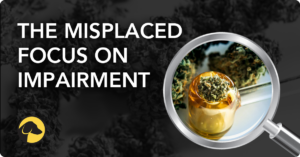
Closing the Gap on Risk Mitigation Strategy
Before cannabis legalization, organizations could create cannabis testing policies centered around zero-tolerance, as the drug’s use was uniformly illegal. Policy-holding employers could deter employee cannabis use with testing methods that prohibited use. But over the last decade, the patchwork of laws related to cannabis has created pain points for both carriers and their insureds – leaving employers with questions about how to appropriately balance risk now that more than 134 million adults in the U.S. have access to legal cannabis. 1
Some organizations have reduced or even discontinued their cannabis testing efforts, thinking this will protect the privacy of employee activity outside of work. These decisions are made, in part, because traditional testing methods – including oral fluid, urine, and hair – may present a greater chance of returning positive results due to their extended detection windows. But dropping THC from a workplace drug testing program can create a gaping hole in a company’s risk mitigation strategy.
WHAT’S REALLY AT RISK
Workday cannabis use can potentially increase the number of workers’ compensation claims due to the higher risk of safety and security incidents occurring. A recent National Safety Council (NSC) survey reported more than half of the employers that stopped cannabis testing reported increased safety incidents and employee performance issues.2
However, the more considerable risk for a company is the unknown liability. Without the benchmarks provided by cannabis testing, insurers are challenged to interpret information gathered at the first report of a claim. They are left to question if the information is correct; and if the information can be trusted to determine if and how cannabis use may have contributed to a given situation. This uncertainty often leaves them wondering if drug-free workplace policies and their associated discounts are working to reduce risk as intended.
This problem is further complicated when you consider traditional testing methods can’t isolate when an employee used THC based on the positive result. This leaves a variety of unanswered questions, such as:
- Did the employee use hours before the incident?
- Did they use days, weeks, or even months before the incident?
- Was cannabis use even a factor in the incident?
These lingering questions could create additional unknown risks for policyholders. Studies show a 10% probability of a wrongfully terminated employee filing a lawsuit.3 In the era of cannabis legalization, policyholders need objective cannabis policies and testing methods that can help reduce litigation concerns.
KNOW THE PURPOSE
Understanding the effectiveness of an organization’s cannabis testing program can help insurance carriers reduce risk. For greater effectiveness, insurance carriers and their policyholders should come together to create holistic cannabis policies. One question to ask is, ‘What is the purpose of the cannabis testing policy?’ The resounding answer should be to deter use. Instead of waiting to test until after an incident has occurred, preventative policy measures, including the use of random testing, can discourage cannabis use while at work.
Another important aspect of effective workplace testing policies is ensuring access to the latest testing methods capable of isolating recent use. By detecting only recent use, policyholders can move from zero-tolerance policies to modern policies aimed at deterring cannabis use associated with the workday.
THE VALUE OF BREATH TESTING
The HOUND® CANNABIS BREATHALYZER isolates cannabis detection to the workday, giving employers objective data to support testing policies that balance workplace safety with employee fairness and privacy. By updating testing programs to include cannabis breath testing, policyholders can isolate recent use to better address safety-sensitive and post-incident scenarios. Expanding the safety-sensitive category to include cybersecurity, finance, and other risk-sensitive positions can help further close gaps in an organization’s risk mitigation strategy. As with any workplace drug testing policy, policyholders should discuss new testing methods with legal counsel and review options for incorporating them into programs.
LOOKING AHEAD
Insurance carriers and their policyholders have options to modernize policies to address cannabis legalization. By re-evaluating the scope of testing, the purpose of workplace drug testing policies, and introducing breath testing focused on workday use, policyholders can begin improving their risk mitigation strategies.
Ready to introduce a recent use cannabis test but not sure where to start? Check out this blog that has easy steps to implement the HOUND® CANNABIS BREATHALYZER.
This article was originally published by Insurance Journal in November 2022.
Footnotes

March 16, 2023
By JAIME FEINBERG
Share












